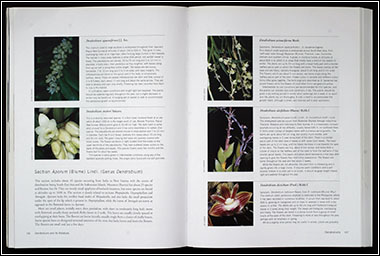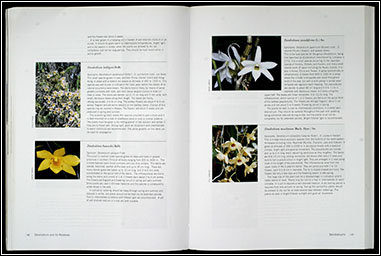Todas as espécies abordadas tem foto, indicação
dos sinônimos, descrição, área de ocorrência,
indicação de cultivo.
As
espécies são tratadas pela nomenclatura tradicional.
Contents:
Parte One: Explores the classification, conservation, evolution,
biology and ecology, traditional use and cultivation in scientifically
accurate but readily understandable terms. The ideas presented on
cultivation are based not only on experience of the authors but
also and an understanding of the biology of the species in their
natural habitats.
Introduction, Classification and nomenclature, Distribution and
Origins, Traditional uses, Conservation, Biology and Ecology, Cultivation,
Artificial Hybrids.
Parte two The Dendrobinae
Describes and illustrates in colour 411 species, including for the
first time in a book at least one species from each of the 48 subgroups
that have been recognized in the dendrobiums. Among the species
illustrated are most of the horticulturally popular species, along
with some rarely seen but spectacular plantas. The island of New
Guinea is the home of the dendrobiums and the book illustrartes
189 New Guinea species.
Sections approached
amblyanthus, Aporum, Bolbidium, Breviflores, Calcarifera, Calista,
Calyptrochilus, Conostalix , Cuthbertsonia, Dendrobium, Dichopus,
Diplocaulobium, Distichophyllum, Dolichocentrum, Eleutheroglossum,
Euphlebium, Formosum, Fytchianthe, Herpethophytum, Kinetochilus,
Latouria, Lichenastrum, MIcrophytante, Monanthos, Oxyglossum, Oxystophyllum,
Pedilonum, Phalaenanthe, Platycaulon, Rhopalanthe, Spatulata, Stachyobium,
Strongyle,
Another genera:
Cadetia, Cannaeorchis, Drockrillia, Epigeneium, Eriopexis, Flickingeria,
Grastidium, Inobulbum, Tetrodon, Winika
|


